|
Related FAQs:
Stony Coral Disease 1,
Stony Coral Disease 2,
Stony Coral Disease 3,
Stony Coral Disease 4,
Stony Coral Disease 5,
Stony Coral Disease 6,
Stony Coral Disease 7,
Stony Coral Disease 8,
Stony Coral Disease 9,
Stony Coral Disease 10,
Stony Coral Disease 11,
Stony Coral Disease 12,
Stony Coral Disease 13,
Stony Coral Disease 14,
Stony Coral Disease 15,
& By Family:
Acroporid Disease,
Acroporid Disease 2,
Acroporid Disease 3, Acroporid Disease 4, Red/Black "Bugs" Acropora Munching
Copepods, Montipora Munching
Nudibranchs, & Caryophyllid
Disease,
Caryophyllid
Disease 2, Elegance Coral
Disease/Pests, Dendrophylliid
Disease, Faviid Disease, Faviid Disease 2, Fungiid Disease, Mussid Disease, Mussid Health 2, Poritid Health, Trachyphylliid Disease, Trachyphyllia Disease 2,
&Cnidarian Feeding
Growing Reef Corals,
Stony Coral
Identification,
Stony Coral Behavior,
Related Articles:
True
or Stony Corals, Order Scleractinia, Growing Reef Corals
/NMA IV
Stress in LPS (Large Polyp Stony) Corals
Definition, Recognition & Avoidance
|
|
| By Bob Fenner |
|
Querying most folks, aquarists and not, finds that they consider
stress something to be avoided. Know thn that some stress is good…
without it our aquarium reefs will suffer akin to the “Boy in a bubble”;
not developing immunity from sudden to prolonged changes in the
environment; a large danger. Still, too much stress is definitely to be
avoided. Too much, too soon can result in loss of Zooxanthellae;
bleaching. It can lead to tissue loss and mortality outright. Here we’ll
delve into the nature of stress in Large Polyp Stony Scleractinians,
what you can and should to avoid it, and what ameliorative steps one
might take if their corals show signs of excessive stress.
To Start; Some Definitions: Stress and LPS
Please forgive my past background as a High School science instructor
here; but defining terms up front helps to clarify a subject, assure
we’re all “talking” about the same things.
First off the term “stress”; this is any phenomenon that
challenges or induces a negative reaction… in our case from a living
organism. As with considerations of kinds of aquarium filtration; it’s
easy to discuss stress divided into inputs that are physical, chemical
and biological in origin. We’ll do so in a bit.
Secondly the label of “LPS”, Large Polyp Stony corals: This
convenient term has become established to include member genera, species
of Scleractinians that are comprised of large, fleshy polyps. Folks in
the know realize that this is an artificial assemblage; that several
families of true stony corals possess both LPS and SPS species. Daniel
Knop sets the difference in size here at smaller than 4 cm. or larger
than 4 cm. (about an inch and a half) to discern large as opposed to
small polyp size species.
|
Some LPS families
are unmistakable in
their being large
polyped; like this
Trachyphyllia geoffroyi
(family
Trachyphylliidae)
|
 |
|
|
|
Other families possess both SPS
and LPS genera, species. Here is
Porites porites on the left, an SPS
found in the Atlantic; and below right a
Flower Pot Coral, genus Goniopora
of the Indo-Pacific ; both of the family
Poritidae.
|

 |
|
|
|
Be this as it may, this distinction of large versus small/er polyp
size is of use to us as aquarists. In captivity, by and large SPS are
more “touchy”; requiring cleaner (less nutrient concentrations…)
settings; more light by and large, and greater attention to meeting
nutritional needs than LPS. This does strike me as strange in some ways,
as the principal Families of hermatypic (reef building) corals, the
Acroporidae, Poritidae and Pocilloporidae comprise the corals most often
exposed at extreme low tides, experience the greatest wave and current
exposure, and are entirely Small Polyp Stony species.
Types of Stress: MANY
Too much or little light, excess and a paucity of nutrients,
allelopathy/pests/predation and much more are common stressors.
Physical Stressors: Include too hot or cold
water, or just too much change in temperature in too short a period of
time. This is the likely single largest factor in natural coral
bleaching; resulting in the expelling, loss of Dinoflagellate species
labeled Zooxanthellae, living in tissues of many Cnidarians and other
sea life.
|
Aquarists who are dive travelers
realize that our tanks are artificial
replacements in many ways; one big one:
How they’re illuminated. Yes; it is
bright near the equator; even
underwater… at “high” noon. But the
intensity of light is never constant and
quickly drops off with the angle of the
sun to the water’s surface, the depth of
water, waves and more. Suffice it to
state that it is rare indeed that the
corals that are wild collected or
aquacultured in situ in the ocean
receive the amount of light energy we
provide. Newly acquired
specimens/colonies need to be gradually
photo-adapted to new settings, placed in
shadier settings, deeper in the water,
or the light attenuated, possibly shaded
itself to prevent over-driving
photosynthesis. Here a new Acanthastrea
is set on the bottom off to the side of
overhead lighting.
|
 |
|
|
|
Sudden or extended overheating may
result in bleaching; the expulsion of
endosymbiotic algae. Below, a Galaxea
fascicularis was overheated from a
combination of low tide and sun exposure
in the upper Gulf of Aqaba, Red Sea. IF
the skeleton remains intact and doesn’t
become overgrown with algae, there is
hope that tissue growth may return to
the lost coralites.
|
 |
|
|
Chemical Stressors:
|
There are as many types of
chemical stressors as there are
chemicals that occur in marine
environments. Too little or too much of
some is real trouble. In particular the
mentality of many aquarists that
“cleanliness is sterility”; utilizing
high tech. equipment and chemical
filtrants, along with scant feeding to
produce a nutrient-limited system. Know
then that all photosynthetic life
requires the essential elements N, P, K…
Unless you’re supplying Nitrogen,
Phosphate and Potassium via foods; you
are starving your corals if there is no
measurable amount of these in your
water. Too much is of course as bad as
too little; you want some percent of
Nitrate, and a few hundredths of a
percent of soluble Phosphate. Below is
an example of a coral lost and being
overgrown by algae from eutrophication
(too much nutrient) in Palau Redang,
Malaysia.
|
 |
|
|
Biological Stressors: Abundant and diverse are
life forms that can challenge LPS; most notably other Cnidarian life can
pose serious risk in the way of allelopathogenic attack. Allelopathogens
are chemicals released by one species that mal-affect others, not
necessarily immediately next to them. Unfortunately most aquarium
systems are smallish in volume and overcrowded. Should “something”
trigger a toxic species (of which there are MANY) they can produce and
excrete undesirable compounds into the water that impugn susceptible
species in the system. This is a very common source of stress and loss
in reef aquariums.
|
Many other ways that Cnidarians
contest with each other exist. There is
over-shading for instance where one
species grows out blocking light and
possibly current from a colony below.
Here in Bonaire a sea fan (Gorgonia
ventalina) blocks light and current
from the stony corals around its base.
|
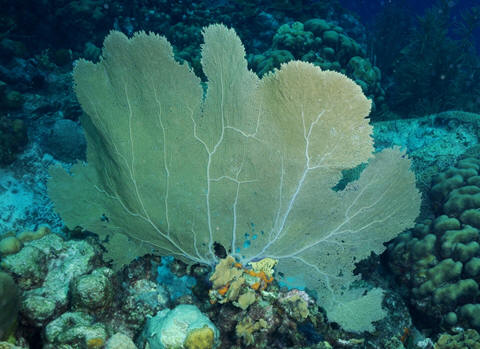 |
|
|
|
Many folks misconstrue the world’s
reefs to be idyllic, peaceful places
where life is somehow living in
co-dominant co-existence. This is not
so; reef areas are battle grounds where
life competes for space, food,
reproduction… Below are two Montipora
spp. fighting across a demilitarized
zone for turf. Stressful? You bet.
|
 |
|
|
|
Stinging, via mesenterial
filaments and more is a type of
“digestive dominance” where one or both
parties lose. Providing plenty of space
twixt colonies is important with very
stinging species like Galaxeas (family
Oculinidae), Euphylliids and
Caryophylliids. A good foot (30 cm.) is
not too much gap to provide. Below; a
scrunched down stung Catalaphyllia.
|
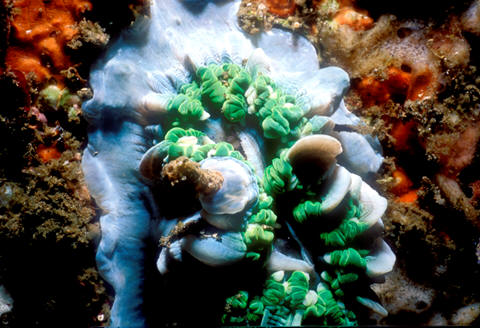 |
|
|
|
Sudden to permanent polyp
withdrawal from a living skeleton is
cause of dire concern. Some agent is
assuredly at work here; stinging perhaps
crawling or worse, sampling the living
tissue as food. Be alert and observant,
consider moving the impacted specimen,
possibly to another system or lighted
refugium.
Below, a mal-affected Goniopora and a
Euphyllia with tissue-removed skeletal
area.
|
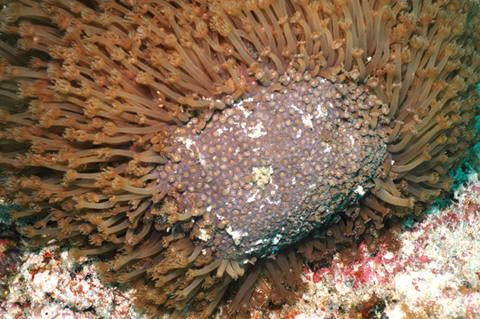
 |
|
|
|
|
Indications of Coral Stress:
|
The easiest sign to spot early on
is that your corals are simply not
opening when they should. Most species
extend their polyps by night in the
wild… for feeding on nocturnal plankton
and avoiding predation by day. Many do
become reverse adapted due to being fed
during lights on hours in captivity.
Below, a fully extended Acanthophyllia
in Raja Ampat, Indonesia.
|
 |
|
|
|
Losers in allelopathogenic battles
should be removed to another system if
possible as soon as practical. Supplying
them with a trebled dose of iodide-ate,
a slightly lowered specific gravity (a
thousandth or so) and adding a
simple/hexose sugar at a level teaspoon
per ten gallons may enable to speed
recovery. The main, display system may
benefit from massive water change
as well as application of granulated
activated carbon and Polyfilter or
equivalent in the filter, circulation
path.
|
 |
|
|
Stress Avoidance:
The best way to combat the ill-effects of stressing your corals is to
avoid pushing their buttons period. Stocking with hardy LPS species is a
good idea, especially for beginners; initial isolation/quarantine to
assure health, proper acclimation, introduction of new specimens to your
established system and careful placement to avoid upsetting potentially
unfriendly competitors.
I should make a comment concerning only adding LPS, actually any corals
to a just set-up system. Don’t do this. These animals require thoroughly
established circumstances. Wait a good few months into a just new
aquarium to stock your corals; better to cure your live rock in place,
start your fish and other hardy invertebrate stocking ahead of
introducing large polyp stony corals.
|
Some of the easier LPS Corals to
keep.
|
|
Caulastrea species; Candy Cane
corals.
Usually peaceful toward other
Cnidarians; undemanding in terms of
water flow and moderate lighting; easily
placed at all levels in the aquarium.
Here’s a small C. furcata colony in
Raja Ampat, Indo.
|

|
|
Cynarina species; Button Corals.
These uber-fleshy polyps are amongst the
safest LPS to stock; getting along with
most all fishes and non-fish livestock.
Moderate lighting and reduced current
suits Cynarina well. Here’s a C.
lacrymalis in S. Sulawesi, Indo.
|

|
|
Favites species; Pineapple corals.
Aggressive species that need to be
placed apart of other corals. Appreciate
moderate light intensity and medium
water flow. Several color varieties and
species are offered from time to time in
the trade. Here’s a F. halicora
in Fiji.
|

|
|
Lobophyllia species; another group
called Brain Corals. These corals can be
aggressive toward other Stinging-Celled
species, so you’ll want to allow several
centimeters of space around their
colonies. Lobo’s get along with moderate
current and a range of light intensity.
There are many color varieties to choose
from; these L. hemprichii in Bali, Indo.
|

|
|
Nemenzophyllia turbida; Fox Coral.
A peaceful species that can be placed
anywhere in the aquarium; even on the
substrate. Does fine with moderate
lighting and current. This one in N.
Sulawesi, Indo.
|

|
|
Plerogyra species; Bubble Coral. A
group of species that are aggressive
with other corals; needs a good 15 cm.
(six inches) of no-man’s land about it
to disallow it to reach out and touch
someone with its stinging mesenterial
filaments. Moderate light and current
will do for Plerogyras. Here’s a typical
colony of P. sinuosa off of Queensland,
Australia.
|

|
|
Trachyphyllia geoffroyi;
Brain Coral (one of a few species with
this common name. A compact species that
may be aggressive toward other corals
(needs to have several inches empty
space about it); placed on the bottom is
best, amongst lower current and light
intensity. This specimen in an aquarium
in Sacramento, CA.
|
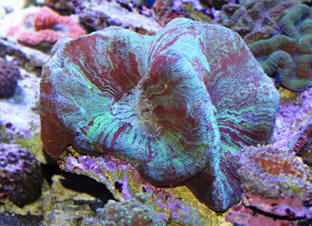
|
|
Turbinaria species; Pagoda et al.
corals. A peaceful genera of
Dendrophyllids; best kept on the bottom
in medium current and subdued lighting.
This small T. peltata in an
aquarium.
|
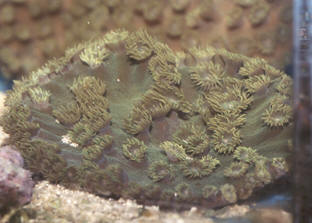
|
|
Do know that with proper
acclimation, introduction and growing
together, many would-be incompatible
corals can be grown together. The
practice of isolation, quarantine of new
specimens, the gradual mixing of water
between the systems to introduce
contenders, placement to allow for
growth; and the all important element of
patience is rewarded by all getting
along; as these two Euphyllias here in
captivity.
|
 |
|
|
General Treatment for Coral Stress:
It is a matter of course that avoiding stress is better than treating
for its mal-affects. This involves providing optimized, stable
conditions: Proper water quality including the usual values, range for
pH, alkalinity and biominerals of use; circulation, lighting regimen,
nutrition…
Immediate response to apparent stressing is identification of the
stressor/s and their alleviation. Really; should the temperature be too
high, turn it down; the specific gravity too low, raise it. If nothing
is apparently awry, when, where in doubt, execute a water change of good
percentage (25 or so); add a few times dose of iodide-ate and STAY
OBSERVANT. Addition of granulated activated carbon, PolyFilter or
equivalent in the water, filter flow path may be warranted.
|
Examples of overt stress in
corals: Tissue loss; along with
bleaching and not opening polyps are
first observable evidence of stress.
Below a Cynarina lacrymalis is
showing its septal teeth as it has
withdrawn and lost flesh over the
calcareous skeleton. Heron Island,
Australia. Compare this with a
full-fleshed robust specimen in the Red
Sea.
|
 |
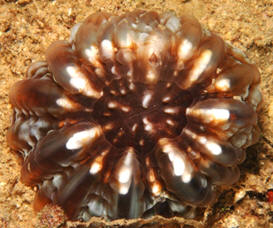 |
|
|
|
Bibliography, Further Reading:
Blue Zoo Aquatics, 2016. LPS & SPS; Less
than ideal terms.
https://www.bluezooaquatics.com/resources.asp
Borneman, Eric. 2002, The Coral Whisperer: Bleaching and Tissue
Loss in Corals - What's the Difference?
http://www.advancedaquarist.com/2002/2/coral
National Ocean Service (NOAA), 2005. What is
Coral Bleaching?
http://oceanservice.noaa.gov/facts/coral_bleach.html

